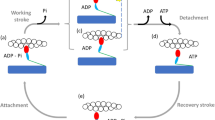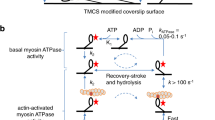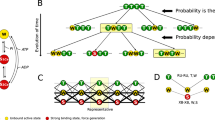Abstract
OUR knowledge of the nature of muscular motion has hitherto been divided into two main fields of successful analysis. First there was the discovery of the phosphorylation cycles whereby energy is transferred from carbohydrate breakdown to the muscle fibre; here the earliest landmarks were the investigations of Fletcher and Hopkins1 and of Harden and Young2 (see the papers of Parnas3 and D. M. Needham4 for up-to-date reviews). Secondly, there was the discovery of the elongated or anisometric character of the particles of muscle-globulin (myosin), demonstrated in the classical paper of v. Muralt and Edsall5, leading to the application of X-ray techniques to the problem, and the establishment by Astbury6,7, that muscular contractility is essentially a molecular contractility of protein chains. The exact connexion between these two orders of fact, however, still remains obscure.
This is a preview of subscription content, access via your institution
Access options
Subscribe to this journal
Receive 51 print issues and online access
$199.00 per year
only $3.90 per issue
Buy this article
- Purchase on Springer Link
- Instant access to full article PDF
Prices may be subject to local taxes which are calculated during checkout
Similar content being viewed by others
References
Fletcher, W. M., and Hopkins, F. G., J. Physiol., 35, 247 (1907).
Harden, A., and Young, W. J., Proc. Roy. Soc., B, 82, 321 (1910).
Parnas, J. K., Ergebn. d. Enzymforsch., 6, 57 (1937).
Needham, D. M., Enzymologia, 5, 158 (1938).
v. Muralt, A., and Edsall, J. T., J. Biol. Chem., 89, 315 and 351 (1930).
Astbury, W. T., ‘Fundamentals of Fibre Structure” (Oxford, 1933); Proc. Roy. Soc., B, 127, 30 (1939); Ann. Rev. Biochem., 8, 113 (1939).
Astbury, W. T., and Bell, F. O., Cold Spring Harbor Symp. Quant. Biol., 6, 109 (1938); Astbury, W. T., and Dickinson, S., Proc. Roy. Soc., B, 129, 307 (1940).
Engelhardt, W. A., and Ljubimova, M. N., NATURE, 144, 668 (1939); Biochemia, 4, 716 (1939).
v. Szent-Györgyi, A., and Banga, I., Science, 93, 158 (1941).
Lawrence, A. S. C., Needham, J., and Shen, S. C., NATURE, 146, 104 (1940).
Edsall, J. T., and Mehl, J. W., J. Biol. Chem., 133, 409 (1940).
Langmuir, I., J. Chem. Phys., 6, 873 (1938).
v. Muralt, A., Archiv f. d. g. Physiol., 230, 299 (1932).
Buchtal, F., and Knappeis, G. G., Skand. Archiv f. Physiol., 78 97 (1938).
Greenstein, J. P., and Edsall, J. T., J. Biol. Chem., 133, 397 (1940).
Kalckar, H., Chem. Rev., 28, 71 (1941), Biol. Rev., in the Press.
Author information
Authors and Affiliations
Rights and permissions
About this article
Cite this article
NEEDHAM, J., SHEN, SC., NEEDHAM, D. et al. Myosin Birefringence and Adenylpyrophosphate. Nature 147, 766–768 (1941). https://doi.org/10.1038/147766a0
Issue Date:
DOI: https://doi.org/10.1038/147766a0
This article is cited by
-
Crossbridge activity monitored from the state of polarization of light diffracted by activated frog muscle fibres
Journal of Muscle Research and Cell Motility (1990)
-
�ber die hypokal�mische Form der paroxysmalen L�hmung
Deutsche Zeitschrift f�r Nervenheilkunde (1961)
-
Die contraction Proteine (Actin-Myosin) im Uterusmuskel
Archiv f�r Gyn�kologie (1955)
-
Kontraktion, ATP-Cyclus und fibrilläre Proteine des Muskels
Ergebnisse der Physiologie Biologischen Chemie und Experimentellen Pharmakologie (1952)
-
�ber den Arbeitsstoffwechsel des im Wundstarrkrampf befindlichen Kaltbl�termuskels
Pfl�gers Archiv f�r die Gesamte Physiologie des Menschen und der Tiere (1949)
Comments
By submitting a comment you agree to abide by our Terms and Community Guidelines. If you find something abusive or that does not comply with our terms or guidelines please flag it as inappropriate.



